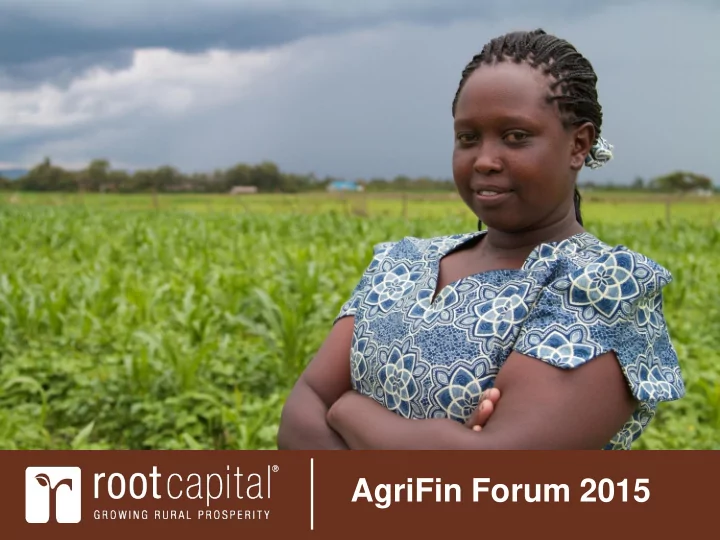

AgriFin Forum 2015
Our Mission Grow rural prosperity by investing in small and growing agricultural businesses that build sustainable livelihoods in Africa and Latin America.
Financing the Rural “Missing Middle”
Capital Constraints Facing African Agriculture 70 % loans to agriculture 60 Contribution of agriculture to total GDP, % 50 40 % 30 20 10 0 Congo Kenya Nigeria Niger Senegal Benin Burkina Cote Guinea Mali Faso d'Ivoire Bissau Source: SCOPEinsight , “Mainstream Agrifinance : Enable producer organizations to invest their way out of poverty.” Compliments of AGRA: CIA World Fact Book, Central Bank of Congo, Central Bank of Nigeria, Central Bank of Kenya, Central Bank of South Africa; BCEAO – Annual Report 2008
Our Three-Pronged Model Finance Impact Advise
Organizational Overview Investors $120M Capital Under Management Institution 8% Corporate 14% 97% Individual 13% Repayment Rate from Borrowers $835M Foundation 34% Cumulative Disbursements Government and Multilateral Since 1999 31% 80% Operational Amount Outstanding as % of Total Notes Payable Self-Sufficiency
2014 Lending $1.1B $842M $178M Loan Enterprise Payments Enterprise Disbursements to Farmers Revenue 279 655K 672K Enterprises Farmers Hectares $178M Annual Loan Disbursements $122M $122M $113M $80M $57M $41M $28M $20M $15M 2005 2006 2007 2008 2009 2010 2011 2012 2013 2014
Financing Agricultural Value Chains Technical Assistance Post-harvest handling and processing Agronomic practices Financial planning Post-harvest handling Cost accounting Internal credit system development Agricultural Smallholder Farmers Buyer Enterprise Commercial Banks Specialized Ag Lenders Microfinance Institutions Savings & Credit Cooperatives Loans for Working Capital Local NGOs Loans for Pre-Harvest Credit Loans for Capital Expenditure Loans for Farm Renovation
Triangulating with Buyers Agricultural Enterprise Buyer (Borrower) Root Capital
Case: Financing Cashew Exports in West Africa Annual Disbursements – West African Cashew $8.7M $4.1M $3.0M $1.8M 2011 2012 2013 2014 An Example of Enterprise Growth $200K $2M WORKING CAPITAL LOAN WORKING CAPITAL LOAN 200 660 EMPLOYEES EMPLOYEES (75% women) (90% women) $196K $1.7M IN PAYMENTS TO FARMERS IN PAYMENTS TO FARMERS
Challenges 1. Informality of many value chains 2. Disaggregation of farmers 3. Absorptive capacity of enterprises 4. Availability of collateral and registration process 5. Currency risk 6. Market volatility 7. Crop failures
Case: Financing the Sorghum Value Chain in Ghana Connecting smallholder farmers with a high-value market 1. Structuring the Transactions 2. Impact 3. Collaboration 4. Lessons Learned 5. Future Opportunities
Case: Financing the Sorghum Value Chain in Ghana Connecting smallholder farmers with a high-value market 1. Structuring the Transactions • Fit and alignment with Root Capital's mission and selection criteria • Understanding the financing need – nature of business, production cycle, use of funds, amount required and timing • Stages of the value chain at which financing is required: pre- and post-harvest • Pricing and currency issues • Risk assessment and mitigation – collateral and insurance • Access to Forex by aggregators for transfer to Root Capital • Scheduling of repayments • 1st year structured as fixed monthly payment beginning from harvest period • 2nd year changed to a flexible repayment based on aggregator's cash flows
Case: Financing the Sorghum Value Chain in Ghana Connecting smallholder farmers with a high-value market 2. Impact • In 2013, increased access to credit for aggregators; previously these businesses struggled with inadequate finance offerings from a local MFI • Continued financing in 2014 with increased loan amounts and financed a third aggregator • Improved access to production inputs for sorghum farmers • Increased income for farmers consequently increased food security • Of 205 farmer surveyed, 85% reported increased incomes of 50%+ • Average reported productivity increases of 130% • Income gains reduced household pressure to sell food crops when cash was scarce and improved food security • Increased output and supply to GGBL
Case: Financing the Sorghum Value Chain in Ghana Connecting smallholder farmers with a high-value market 3. Collaboration • Barclays Bank serves as co-financier and supported funds transfer to Root Capital • Guinness Ghana Limited acts as buyer of farmers’ produce, reducing the risk of the transaction by serving as a stable off-taker • AGRA/Concern Universal is providing valuable technical assistance to aggregators and producers • Currently in discussion with IFDC to link aggregators to fertilizer suppliers
Case: Financing the Sorghum Value Chain in Ghana Connecting smallholder farmers with a high-value market 4. Lessons Learned • Increased understanding of the dynamics of domestic value chains • Managing FX risk associated with the transaction 5. Future Opportunities • Finance more aggregators to increase sorghum supply • Replicate in other countries in which GGBL operates (e.g., Cameroon, Nigeria) • Replicate in other crops that are part of GGBL supply chain (e.g., maize, cassava) • Link other multinationals to local sources of sustainable agricultural commodities
Recommend
More recommend